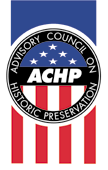 About ACHP
About ACHP ACHP News
National Historic
Preservation
Program
Working with
Section 106
Federal, State, & Tribal Programs
Training & Education
Publications
Search
Home
Moffett Field Release - ACHP Issues Official Comments Regarding Fate of Hangar 1, Moffett Field
�WASHINGTON, DC – Following its Sept. 17, 2008 public hearing in Mountain View, the Advisory Council on Historic Preservation (ACHP) today recommended in its final comments that the Department of the Navy and the National Aeronautics and Space Administration (NASA) work together to rehabilitate historic Hangar 1 at Moffett Field and find a suitable contemporary use for the structure.
The Navy had proposed the removal of the skin of the hangar and to essentially “mothball” the supporting framework after coating it with materials designed to retard deterioration. However, the ACHP’s formal response to that plan notes that “without a specific commitment to re-skin the hangar … the remaining exposed frame will no longer be considered a building. Exposed to the elements, this frame will surely begin to deteriorate and eventually become unsuitable for reuse. With the passage of time, we fear that demolition will be the likely outcome.”
The ACHP’s formal findings and recommendations came in letters addressed to Michael D. Griffin, NASA administrator, and Donald C. Winter, secretary of the Navy. The letters were conveyed by John L. Nau, III, ACHP chairman. The complete text of those letters can be found at www.achp.gov/moffettfieldnavy and www.achp.gov/moffettfieldnasa.
A three-member ACHP panel hosted a public meeting Sept. 17, 2008 at the Hahn Auditorium in the Computer History Museum, 1401 N. Shoreline Blvd., Mountain View, California. The purpose of the meeting was to gather public input on the Navy’s preferred removal action alternative and its effect on the historic integrity of Hangar 1 and solicit ideas for measures or conditions on this action that would avoid, minimize, or mitigate the potential adverse effects to the hangar. Hangar 1 is individually eligible for listing on the National Register of Historic Places and is a contributing element of the National Register listed U.S. Naval Air Station Sunnyvale, California, Historic District.
While the Navy and NASA will make the ultimate decisions regarding the hangar’s fate, Nau’s comments remarked upon the unique historic importance and architectural significance of Hangar 1.
“Hangar 1 is an important historic resource due to its use and association with a significant episode in the development of naval aviation prior to World War II, and its architectural design as an example of early twentieth century military planning, engineering and construction in the Streamline Moderne style,” Nau said. The official comments also noted that many residents of the area consider Hangar 1 to be an iconic structure.
About the ACHP: An independent, federal agency, the ACHP promotes the preservation, enhancement, and productive use of our nation’s historic resources, and advises the President and Congress on national historic preservation policy. It also provides a forum for influencing federal activities, programs, and policies that affect historic properties. In addition, the ACHP has a key role in carrying out the Administration’s Preserve America initiative. See www.achp.gov for more information.
Posted October 7, 2008